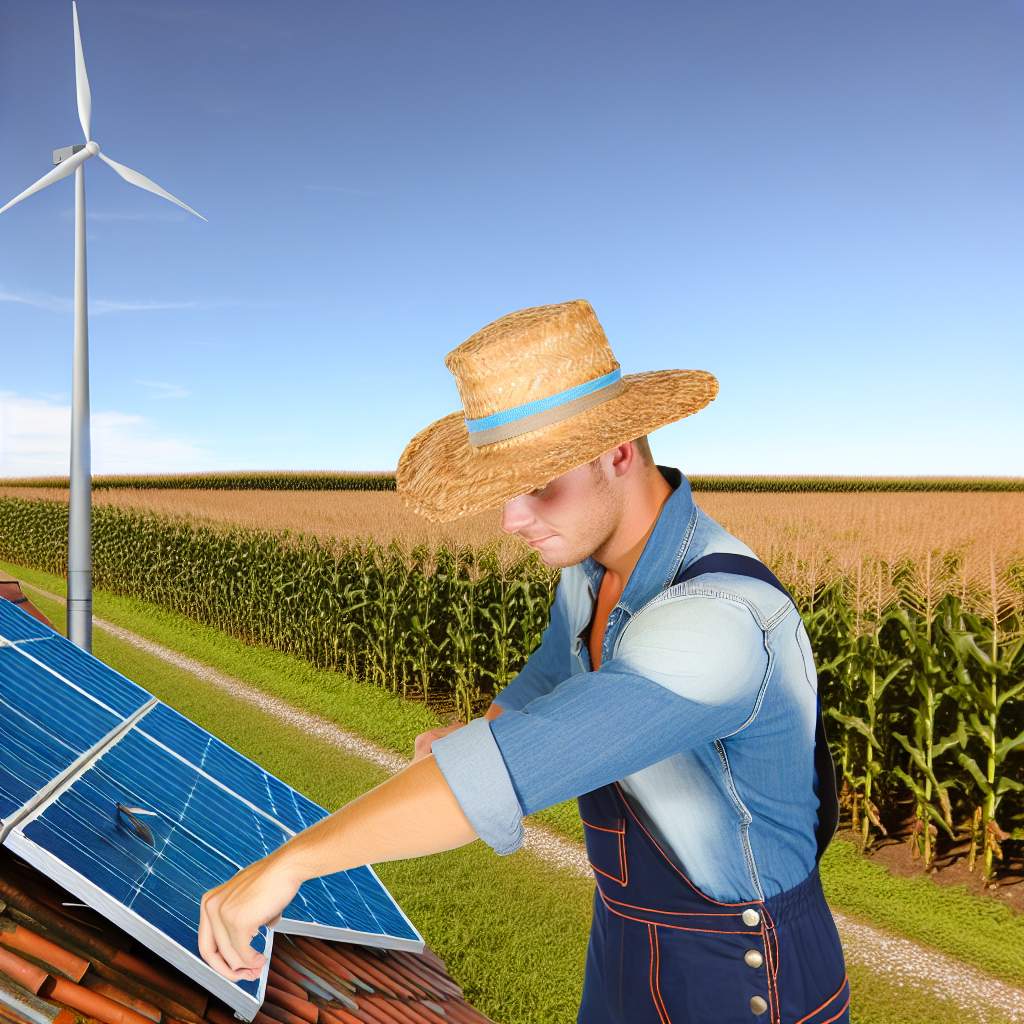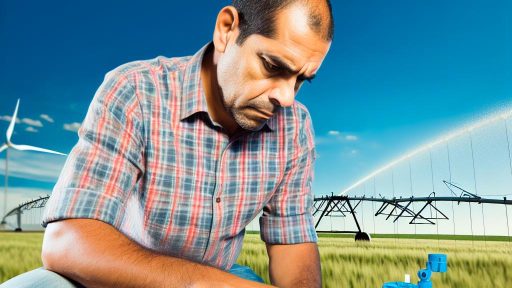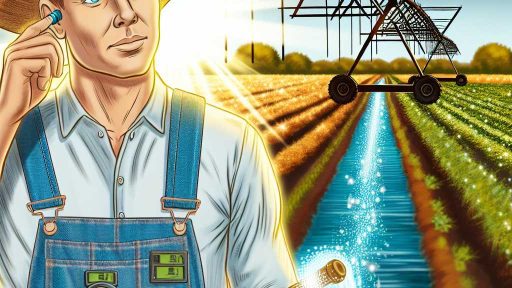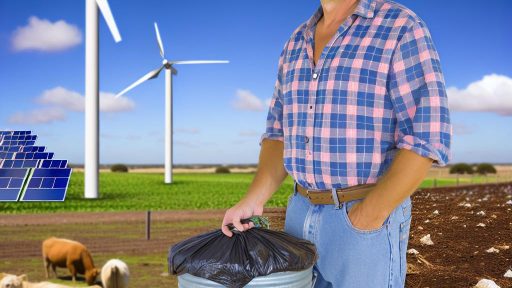Introduction to Wind Energy in Agriculture
Wind energy plays a vital role in modern agriculture.
It offers a sustainable solution to rising energy costs.
Farmers increasingly turn to wind as a clean energy alternative.
This renewable resource reduces reliance on fossil fuels.
Moreover, it enhances overall farm energy efficiency.
Understanding Wind Energy
Wind energy harnesses the kinetic power of wind.
Wind turbines convert this energy into electricity.
This process significantly decreases greenhouse gas emissions.
Consequently, it contributes to a healthier environment.
Advantages of Wind Energy in Agriculture
- Lower operational costs lead to improved profit margins.
- Wind energy promotes energy independence for farms.
- This energy source supports sustainable farming practices.
- Wind turbines can operate alongside existing farming operations.
Real-World Applications
A variety of farms utilize wind energy effectively.
For instance, dairy farms leverage this energy to power equipment.
Additionally, crop farms use wind systems for irrigation systems.
These applications demonstrate wind energy’s versatility.
Farmers like Maria Gomez have successfully integrated turbines.
The Future of Wind Energy in Agriculture
As technology advances, wind turbines become more efficient.
Transform Your Agribusiness
Unlock your farm's potential with expert advice tailored to your needs. Get actionable steps that drive real results.
Get StartedFarmers will likely adopt this energy source at an increasing rate.
In addition, governmental incentives may enhance adoption.
Ultimately, wind energy offers promising benefits to agriculture.
Benefits of Wind Turbines for Farm Operations
Reducing Energy Costs
Wind turbines significantly lower energy expenses for farm operations.
By harnessing wind energy, farmers can reduce reliance on fossil fuels.
This shift leads to noticeable savings on electric bills across seasons.
Moreover, wind energy often proves to be a more stable cost over time.
As fossil fuel prices fluctuate, wind energy remains a consistent alternative.
Enhancing Financial Sustainability
Integrating wind turbines boosts overall financial health for farms.
This integration provides a new revenue stream through energy sales.
Additionally, farmers can benefit from government incentives for renewable energy.
Tax credits and grants make wind turbine investments financially attractive.
Consequently, farms can balance operational costs and enhance profit margins.
Furthermore, sustainable energy practices improve brand reputation among consumers.
As a result, farms become more appealing to environmentally conscious buyers.
Supporting Long-Term Energy Independence
Wind turbines promote energy independence for agricultural enterprises.
This independence reduces vulnerability to energy market volatility.
By generating their own power, farmers gain control over energy sources.
Consequently, they can plan for long-term operational stability.
As energy needs continue to rise, wind energy serves as a reliable solution.
Investing in wind turbines positions farms advantageously for the future.
Types of Wind Turbines Suitable for Farms
Small-Scale Wind Turbines
Small-scale wind turbines are ideal for individual farms.
They usually generate between 1 kW to 10 kW of power.
Farmers can use them for on-site energy needs.
Showcase Your Farming Business
Publish your professional farming services profile on our blog for a one-time fee of $200 and reach a dedicated audience of farmers and agribusiness owners.
Publish Your ProfileAdditionally, these turbines can offset electricity costs.
Small turbines often require less space and lower initial investment.
They are perfect for supplementing solar energy systems.
Furthermore, small-scale turbines are easier to install and maintain.
Large-Scale Wind Turbines
Large-scale wind turbines produce more energy, ranging from 100 kW to several Megawatts.
These turbines are often used in wind farms and require more land.
They are suitable for farms with extensive land available.
Larger turbines can connect to the grid, providing extra revenue.
Farmers can sell surplus energy back to the grid.
This arrangement also supports local renewable energy goals.
Applications in Agricultural Settings
Wind turbines can power various farm operations.
They can supply energy for irrigation systems.
Turbines can also be used to power equipment like barn ventilation systems.
Moreover, wind energy can support livestock facilities.
Integrating turbines reduces reliance on fossil fuels.
This transition contributes to sustainable farming practices.
Benefits of Wind Energy on Farms
Wind energy enhances overall energy efficiency.
It offers financial savings through reduced energy bills.
Farmers can achieve energy independence with wind power.
Furthermore, wind energy can increase property value.
Investing in turbines aligns with environmental sustainability initiatives.
You Might Also Like: Balancing Soil Nutrients for Sustainable and Profitable Farming
Site Assessment for Wind Turbine Installation
Evaluating Land Resources
Begin by analyzing the characteristics of the land available for wind turbine installation.
Soil type, topography, and land use will influence turbine placement decisions.
Evaluate any obstructions such as buildings and trees that could affect wind flow.
Lastly, consider the proximity to existing infrastructure for electricity distribution.
Assessing Wind Resources
Wind speed is a crucial factor in turbine efficiency.
Obtain historical wind data for the site to determine the average wind speed.
Use anemometers to measure real-time wind conditions at various heights.
Higher elevations may yield stronger and more consistent winds.
Conducting a Wind Resource Assessment
Develop a comprehensive wind resource assessment over a specific timeframe.
Collect data on wind direction and turbulence intensity that may impact turbine performance.
Use this data to create wind roses that visualize wind patterns.
Consulting with Experts
Consulting with renewable energy professionals can enhance your assessment accuracy.
Experts can provide insight into effective turbine models suited for your location.
Their experience can help identify potential hurdles and solutions during installation.
Considering Environmental Impact
Examine the potential environmental effects of installing wind turbines.
Conduct studies to assess impacts on local wildlife and ecosystems.
Ensure compliance with environmental regulations to secure necessary permits.
Planning for Future Expansion
While assessing the site, consider possible future expansion of wind resources.
Showcase Your Farming Business
Publish your professional farming services profile on our blog for a one-time fee of $200 and reach a dedicated audience of farmers and agribusiness owners.
Publish Your ProfileLeave space for additional turbines that could enhance energy generation.
Effective planning can maximize both current and future energy potential.
Learn More: Implementing Wind-Driven Turbines For Sustainable Livestock Feed Production
Integration of Wind Energy with Existing Farming Practices
Understanding the Benefits of Wind Energy
Wind energy offers a renewable solution for powering farm operations.
It reduces reliance on fossil fuels.
This, in turn, helps lower operational costs.
Farmers can harness wind energy to power machinery and irrigation systems.
Additionally, using wind turbines can increase energy independence.
Assessing Site Suitability
Before installing wind turbines, farmers must evaluate their land.
They should consider wind patterns and average wind speeds.
Conducting a site assessment helps ensure optimal placement for turbines.
Moreover, this process helps meet energy needs effectively.
Blending Wind and Traditional Farming Practices
Integrating wind energy into farming can enhance traditional practices.
For instance, farmers can use turbine-generated electricity for water pumps.
This integration improves irrigation efficiency, reducing water wastage.
Additionally, wind turbines can supplement energy for grain drying processes.
Creating a Sustainable Energy Plan
Farmers should develop a clear energy management strategy.
They can start by calculating energy consumption patterns.
From there, they can determine the appropriate size and number of turbines.
Cooperating with energy consultants can provide valuable insights.
Engaging the Community
Farmers can promote wind energy benefits to their communities.
Hosting informational workshops can enhance local awareness.
Additionally, collaborating with local governments can encourage wind energy adoption.
Community support can lead to a more favorable regulatory environment.
Monitoring and Maintenance Practices
Regular maintenance is crucial for wind turbine efficiency.
Farmers should schedule routine inspections of turbine components.
Monitoring turbine performance can identify potential issues early.
By maintaining turbines, farmers can ensure reliable energy generation.
Discover More: Understanding Animal Welfare Certifications For Humane Livestock Farming

Regulatory and Financial Incentives for Farmers
Overview of Government Programs
Governments across the globe offer various programs to support farmers in transitioning to renewable energy.
These programs often include grants, loans, and tax credits.
Farmers can significantly reduce the costs of installing wind turbines through these resources.
Additionally, state and local agencies frequently provide specific incentives tailored to their communities.
Subsidies for Wind Energy Adoption
Many farmers benefit from subsidies that help offset the initial investment in wind energy systems.
For instance, federal energy subsidies can cover a substantial portion of installation costs.
Moreover, these subsidies frequently include support for maintenance and operational expenses.
Farmers should investigate local opportunities for additional financial assistance.
Tax Credits and Deductions
Tax incentives play a critical role in making wind energy adoption financially viable for farmers.
Investment tax credits can enable farmers to deduct a percentage of the installation costs from their federal taxes.
Additionally, production tax credits reward farmers for the energy generated by their wind turbines.
Showcase Your Farming Business
Publish your professional farming services profile on our blog for a one-time fee of $200 and reach a dedicated audience of farmers and agribusiness owners.
Publish Your ProfileThese credits can lead to substantial savings over time, improving financial health.
Compliance and Regulatory Support
Navigating regulations can be challenging, but various resources are available to assist farmers.
Government agencies provide guidance for compliance with energy regulations and safety standards.
Moreover, outreach programs connect farmers with experts who can simplify the process.
This support empowers farmers to make informed decisions regarding wind energy projects.
Long-term Economic Benefits
Investing in wind energy not only provides immediate savings but also ensures long-term economic stability.
Farmers can benefit from stable energy prices, reducing vulnerability to fluctuating utility rates.
Additionally, wind energy adoption can increase a farm’s property value.
Ultimately, this transition positions farmers as sustainable leaders within their communities.
See Related Content: Implementing Traceability Protocols To Meet Stringent Organic Certification
Case Studies of Successful Wind Energy Implementation
Sunny Fields Farm
Sunny Fields Farm located in Kansas demonstrates wind energy efficiency.
They installed two wind turbines in 2021 to power their operations.
As a result, their energy costs decreased by 40%.
This allowed them to allocate funds to other sustainability projects.
Green Valley Orchards
Green Valley Orchards in California embraced renewable energy.
They utilized wind turbines to supplement traditional energy sources.
This switch significantly reduced their carbon footprint.
Now, they produce their own energy sustainably.
Maple Ridge Dairy
Maple Ridge Dairy in Wisconsin focused on energy independence.
The farm invested in a large wind turbine in 2019.
This decision helped them achieve full energy self-sufficiency.
Subsequently, they operated without relying on the grid.
Harvest Moon Farm
Harvest Moon Farm, situated in Texas, optimized energy usage.
They integrated wind energy with solar panels for maximum output.
The combination increased their overall energy efficiency.
Consequently, they became a model for local farms.
Future Trends in Wind Technology and Agriculture
Advancements in Wind Turbine Design
Innovative turbine designs are becoming more efficient.
These designs capture wind energy even at low speeds.
Additionally, vertical-axis turbines are gaining popularity.
They are less obtrusive and easier to maintain.
Farmers benefit from these compact and efficient structures.
Integration with Smart Agriculture
Smart technology is transforming wind energy applications.
Farmers are utilizing sensors to monitor energy production.
This data helps optimize energy use on farms.
Moreover, drones can assess turbine performance remotely.
Thus, farmers can manage energy resources effectively.
Hybrid Energy Solutions
Combining wind energy with solar power is trending.
Farmers are creating hybrid systems for greater efficiency.
These systems reduce reliance on conventional energy sources.
They also ensure a more stable energy supply.
Showcase Your Farming Business
Publish your professional farming services profile on our blog for a one-time fee of $200 and reach a dedicated audience of farmers and agribusiness owners.
Publish Your ProfileAs a result, farms can operate sustainably year-round.
Community-Based Wind Projects
Community wind farms are becoming more prevalent.
These projects allow multiple farmers to share resources.
Additionally, they provide economic benefits to local areas.
Communities can sell excess energy back to the grid.
Thus, this practice fosters local energy independence.
Regulatory Support and Incentives
Government policies are increasingly supportive of wind energy.
Financial incentives encourage farmers to adopt wind technology.
Subsidies and grants make initial investments more feasible.
Furthermore, educational programs are promoting awareness.
Farmers now understand the advantages of wind energy.
Additional Resources
AGRI Sustainable Agriculture Demonstration Grant | Minnesota …




